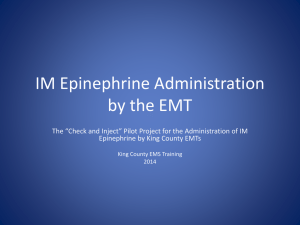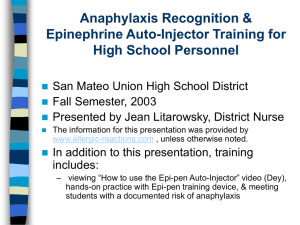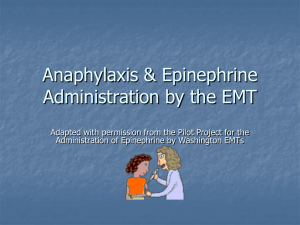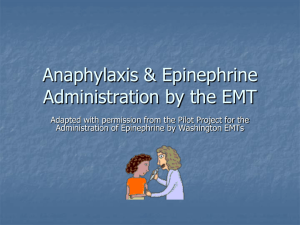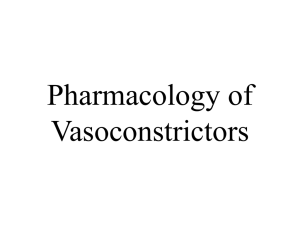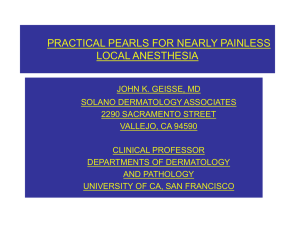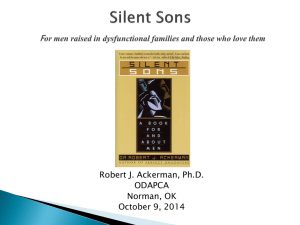Mayo Clin Proc
advertisement
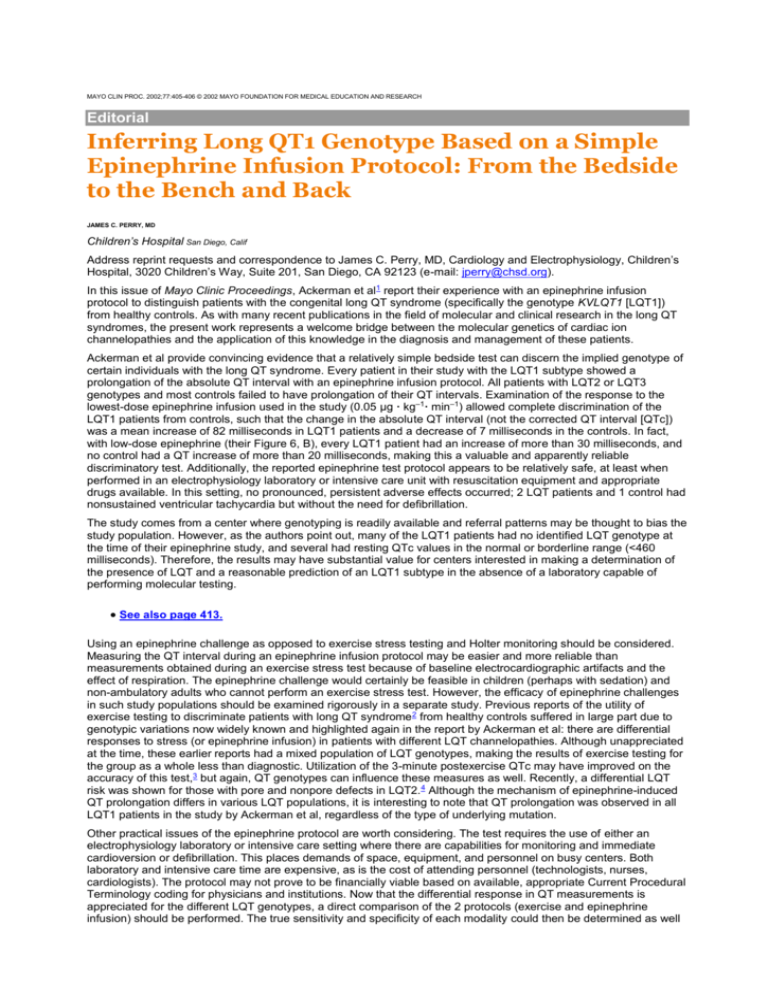
MAYO CLIN PROC. 2002;77:405-406 © 2002 MAYO FOUNDATION FOR MEDICAL EDUCATION AND RESEARCH Editorial Inferring Long QT1 Genotype Based on a Simple Epinephrine Infusion Protocol: From the Bedside to the Bench and Back JAMES C. PERRY, MD Children’s Hospital San Diego, Calif Address reprint requests and correspondence to James C. Perry, MD, Cardiology and Electrophysiology, Children’s Hospital, 3020 Children’s Way, Suite 201, San Diego, CA 92123 (e-mail: jperry@chsd.org). In this issue of Mayo Clinic Proceedings, Ackerman et al1 report their experience with an epinephrine infusion protocol to distinguish patients with the congenital long QT syndrome (specifically the genotype KVLQT1 [LQT1]) from healthy controls. As with many recent publications in the field of molecular and clinical research in the long QT syndromes, the present work represents a welcome bridge between the molecular genetics of cardiac ion channelopathies and the application of this knowledge in the diagnosis and management of these patients. Ackerman et al provide convincing evidence that a relatively simple bedside test can discern the implied genotype of certain individuals with the long QT syndrome. Every patient in their study with the LQT1 subtype showed a prolongation of the absolute QT interval with an epinephrine infusion protocol. All patients with LQT2 or LQT3 genotypes and most controls failed to have prolongation of their QT intervals. Examination of the response to the lowest-dose epinephrine infusion used in the study (0.05 μg · kg–1· min–1) allowed complete discrimination of the LQT1 patients from controls, such that the change in the absolute QT interval (not the corrected QT interval [QTc]) was a mean increase of 82 milliseconds in LQT1 patients and a decrease of 7 milliseconds in the controls. In fact, with low-dose epinephrine (their Figure 6, B), every LQT1 patient had an increase of more than 30 milliseconds, and no control had a QT increase of more than 20 milliseconds, making this a valuable and apparently reliable discriminatory test. Additionally, the reported epinephrine test protocol appears to be relatively safe, at least when performed in an electrophysiology laboratory or intensive care unit with resuscitation equipment and appropriate drugs available. In this setting, no pronounced, persistent adverse effects occurred; 2 LQT patients and 1 control had nonsustained ventricular tachycardia but without the need for defibrillation. The study comes from a center where genotyping is readily available and referral patterns may be thought to bias the study population. However, as the authors point out, many of the LQT1 patients had no identified LQT genotype at the time of their epinephrine study, and several had resting QTc values in the normal or borderline range (<460 milliseconds). Therefore, the results may have substantial value for centers interested in making a determination of the presence of LQT and a reasonable prediction of an LQT1 subtype in the absence of a laboratory capable of performing molecular testing. See also page 413. Using an epinephrine challenge as opposed to exercise stress testing and Holter monitoring should be considered. Measuring the QT interval during an epinephrine infusion protocol may be easier and more reliable than measurements obtained during an exercise stress test because of baseline electrocardiographic artifacts and the effect of respiration. The epinephrine challenge would certainly be feasible in children (perhaps with sedation) and non-ambulatory adults who cannot perform an exercise stress test. However, the efficacy of epinephrine challenges in such study populations should be examined rigorously in a separate study. Previous reports of the utility of exercise testing to discriminate patients with long QT syndrome 2 from healthy controls suffered in large part due to genotypic variations now widely known and highlighted again in the report by Ackerman et al: there are differential responses to stress (or epinephrine infusion) in patients with different LQT channelopathies. Although unappreciated at the time, these earlier reports had a mixed population of LQT genotypes, making the results of exercise testing for the group as a whole less than diagnostic. Utilization of the 3-minute postexercise QTc may have improved on the accuracy of this test,3 but again, QT genotypes can influence these measures as well. Recently, a differential LQT risk was shown for those with pore and nonpore defects in LQT2. 4 Although the mechanism of epinephrine-induced QT prolongation differs in various LQT populations, it is interesting to note that QT prolongation was observed in all LQT1 patients in the study by Ackerman et al, regardless of the type of underlying mutation. Other practical issues of the epinephrine protocol are worth considering. The test requires the use of either an electrophysiology laboratory or intensive care setting where there are capabilities for monitoring and immediate cardioversion or defibrillation. This places demands of space, equipment, and personnel on busy centers. Both laboratory and intensive care time are expensive, as is the cost of attending personnel (technologists, nurses, cardiologists). The protocol may not prove to be financially viable based on available, appropriate Current Procedural Terminology coding for physicians and institutions. Now that the differential response in QT measurements is appreciated for the different LQT genotypes, a direct comparison of the 2 protocols (exercise and epinephrine infusion) should be performed. The true sensitivity and specificity of each modality could then be determined as well as the cost issues for each. Perhaps a new Current Procedural Terminology code will need to be proposed for this type of test. In 1 study,5 nearly 60% of current LQT patients with an identifiable positive genotype have a mutation compatible with an LQT1 genotype. In addition, patients with LQT1 often have equivocal resting QTc measurements. Therefore, a substantial number of patients with borderline QTc measurements who prove to have positive epinephrine protocols could benefit by the availability of a more definitive test. The serious implications of a presumptive diagnosis of LQT in a patient with a borderline QTc on a resting electrocardiogram could be avoided in many patients. A greater number of patients may be needed to establish the validity of the concept, but the current study holds out the promise that if the QT interval does not prolong with an epinephrine challenge, the diagnosis is not LQT1, thereby eliminating confusion for many patients with borderline resting QTc measurements. The results of Ackerman et al are clear: a low-dose epinephrine infusion protocol can help distinguish patients with LQT1 from healthy controls or patients with LQT2 and LQT3. The response to epinephrine may help direct initial genotype investigations for patients with suspected but unproven LQT1. Additional studies are necessary to determine whether the epinephrine protocol can reveal LQT1 to be present in a larger population of borderline QT patients or perhaps in LQT1 carriers in family members of an identified LQT1 proband. Until an adequate number of financially viable, service-oriented molecular cardiology laboratories can provide results of channelopathy genotyping to cardiologists and families in a reasonable time frame, clinical cardiologists at most centers will remain dependent on helpful, discriminating clinical tests to make a presumptive genetic diagnosis. The resting electrocardiogram forms the basis of initial recognition of LQT but clearly misses a substantial number of patients at assumed risk of torsades de pointes and sudden death.6 Patients and their families would pay fees commensurate with the work involved in obtaining an accurate genetic test for LQT and other cardiac channelopathy syndromes. Certainly, these tests could be performed and billed at a cost less than is currently charged for a complete echocardiographic study, while allowing laboratories to remain financially viable (or even prosperous). This report in Proceedings should result in wide application of the epinephrine test to identify patients with the LQT1 genotype. Ion channel–specific and mutation-specific therapies for LQT syndrome are already being investigated and advocated for some LQT patients.7,8 As genotype-specific forms of therapy evolve and become the norm for most patients with long QT syndrome, the need to provide genotyping services for cardiac ion channelopathies becomes imperative. REFERENCES 1. Ackerman MJ, Khositseth A, Tester DJ, Hejlik JB, Shen W-K, Porter CJ. Epinephrine-induced QT interval prolongation: a gene-specific paradoxical response in congenital long QT syndrome. Mayo Clin Proc. 2002;77:413-421. 2. Jackman WM, Friday KJ, Anderson JL, Aliot EM, Clark M, Lazzara R. The long QT syndromes: a critical review, new clinical observations and a unifying hypothesis. Prog Cardiovasc Dis. 1988;31:115-172. 3. Dillenburg RF, Hamilton RM. Is exercise testing useful in identifying congenital long QT syndrome? Am J Cardiol. 2002;89:233-236. 4. Moss AJ, Zareba W, Kaufman ES, et al. Increased risk of arrhythmic events in long-QT syndrome with mutations in the pore region of the human ether-a-go-go-related gene potassium channel. Circulation. 2002;105:794-799. 5. Schwartz PJ, Priori SG, Spazzolini C, et al. Genotype-phenotype correlation in the long-QT syndrome: gene-specific triggers for lifethreatening arrhythmias. Circulation. 2001;103:89-95. 6. Priori SG, Napolitano C, Schwartz PJ. Low penetrance in the long-QT syndrome: clinical impact. Circulation. 1999;99:529-533. 7. Schwartz PJ, Priori SG, Locati EH, et al. Long QT syndrome patients with mutations of the SCN5A and HERG genes have differential responses to Na+ channel blockade and to increases in heart rate: implications for gene-specific therapy. Circulation. 1995;92:3381-3386. 8. Benhorin J, Taub R, Goldmit M, et al. Effects of flecainide in patients with new SCN5A mutation: mutation-specific therapy for long-QT syndrome? Circulation. 2000;101:1698-1706.
